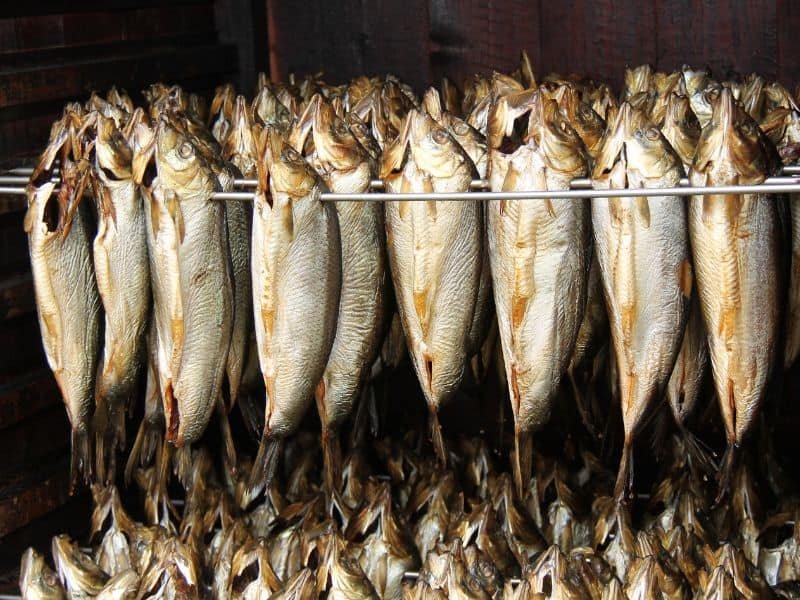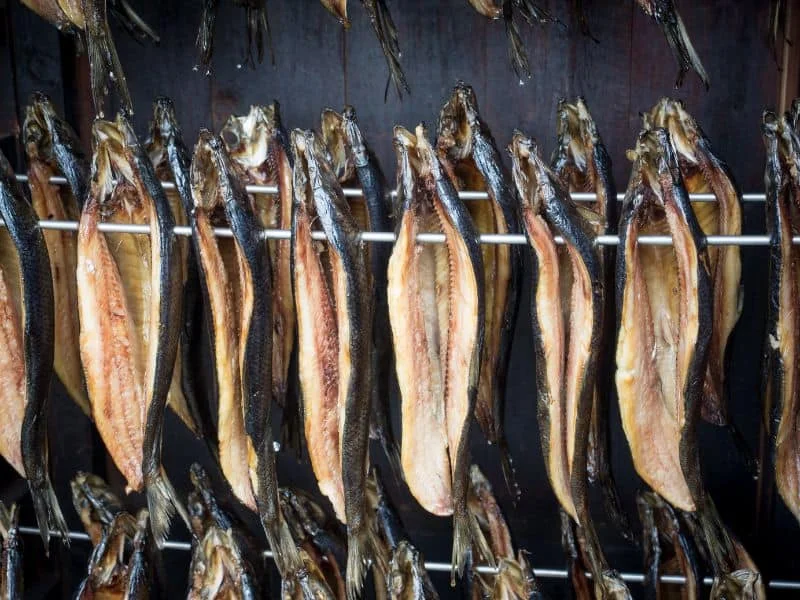Kippers, a traditional British dish, are smoked and salted herring. Known for their strong, distinctive flavor, kippers are a delicious and convenient choice for breakfast or even a light dinner. By learning how to make kippers, you can enjoy this savory treat in the comfort of your own home.

There are various methods of preparing kippers, such as poaching, grilling, or baking. Poaching is the most popular method because it produces the least amount of smell, while still providing a moist and tender outcome.
Which method you choose depends on your personal preference and the tools available in your kitchen.
Before cooking, kippers must undergo a curing process to achieve their characteristic smoky flavor. This involves brining the herring and then cold smoking them for an extended period. Once the curing process is complete, you’re ready to embark on your kipper culinary adventure.
Remember to check your sources for accurate information and link them within your sentences for easy reference. Happy kipper cooking!
What Are Kippers

Kippers are a traditional British breakfast dish made from herring, a small, oily fish. They are known for their smoked taste and rich flavor, making them a popular choice in the UK. In this section, we’ll explore the traditional kippers, the kippering process, and their health benefits.
Traditional Kippers
Traditionally, kippers are served at breakfast, often accompanied by other morning favorites like eggs, toast, and biscuits. Their unique flavor comes from the smoking and curing process, which we’ll discuss in more detail below. Some popular ways to cook kippers include:
- Poaching them in hot water for a few minutes
- Lightly frying them in butter
Kippering Process
The kippering process involves a combination of smoking, curing, and salting. Here’s a breakdown of the steps:
- Herring is first split in half from tail to head
- The fish is then salted to preserve it
- Finally, the fish is smoked, giving it the characteristic kipper flavor
You can learn more about the kippering process here.
Health Benefits
Kippers are more than just a tasty breakfast dish; they also offer several health benefits. As an oily fish, they are:
- Rich in omega-3 fatty acids, which are important for heart health
- A good source of protein, providing essential amino acids for muscle growth and repair
- High in selenium, a mineral that supports a healthy immune system
In addition, kippers contain various vitamins and minerals that contribute to a well-rounded and nutritious diet. So, enjoying kippers as part of your breakfast not only offers a unique taste experience but also provides a healthy start to your day.
Selecting and Buying Kippers
Fresh Kippers
When purchasing fresh kippers, it’s essential to find a reputable source, such as a local fishmonger or a well-stocked supermarket. Look for kippers that have a bright, shiny appearance and a pleasant, smoky aroma. Avoid those with any sign of discoloration, dryness, or strong odor.
- Bright, shiny appearance
- A pleasant, smoky aroma
- No discoloration, dryness, or strong odor
Choosing the right cut of kipper is crucial to a delicious meal. Opt for whole kippers or kipper fillets, depending on your preference and desired cooking method. When comparing kippers to other meat options, such as salmon or beef, remember that kippers have a unique, rich flavor and smoother consistency.
- Whole kippers or kipper fillets
- Unique, rich flavor and smooth consistency compared to salmon or beef
Canned Kippers
For a convenient option, consider canned kippers. These are readily available in supermarkets and online retailers. Look for cans that are tightly sealed and show no signs of bulging or damage. As with fresh kippers, choose your preferred level of smokiness and flavor.
- Available in supermarkets and online
- Tightly sealed cans without damage or bulging
Canned kippers can be an excellent addition to dishes like smoked fish sliders or as a topping on salads. Some varieties come packed with extra flavors, such as mustard, jalapeño, or cracked pepper, allowing for easy experimentation in the kitchen.
- Great for smoked fish sliders or salad toppings
- Available with extra flavors like mustard, jalapeño, or cracked pepper for more variety
Remember to store canned kippers in a cool, dry place until ready to use. Once opened, transfer any unused portion to a sealed container and refrigerate to maintain freshness and avoid spoilage.
- Store in a cool, dry place
- Refrigerate opened cans in a sealed container for freshness and safety
Preparing Kippers
Gutting and Filleting
First, prepare fresh herrings by cutting off their heads and tails with scissors. Next, gut the herrings by making a shallow incision along the belly and removing the innards. After that, split the fish in half by using a sharp knife and running it down the backbones, pressing firmly to cut through the bones. Rinse the fillets under cold water, drain, and pat dry with paper towels.
- Cut off heads and tails
- Gut the fish and remove the innards
- Split fish in half, rinse and pat dry
Adding Flavorings
For simple yet delicious kippers, consider poaching them in hot water for 3 to 4 minutes. The fish should be fully opened and skin side down in a shallow dish. Weigh the kippers down in boiling water with parchment paper and a small cutting board, ensuring they remain submerged during the cooking process.
- Poach in hot water for 3-4 minutes
- Keep kippers submerged with a weight
- Cook skin-side down
Another way to cook kippers is by baking them in a preheated oven at 350°F (180°C). Place the fish on aluminum foil, skin-side down. Add butter, salt, and parsley to taste. Seal the foil packets tightly to trap the steam inside. Bake the kippers for 15-20 minutes until they become opaque and flaky.
- Bake in the oven at 350°F (180°C)
- Season with butter, salt, and parsley
- Seal the foil packets before baking
Mix 1/2 cup of plain yogurt with a tablespoon of sriracha, or your favorite hot sauce. Adjust the seasoning according to your taste preferences.
- Mix plain yogurt with sriracha or your favorite hot sauce
- Serve the sauce with cooked kippers
- Adjust sauce seasoning to taste
Cooking Methods

Poaching Kippers
Poaching kippers is a simple and effective method to cook this delicious fish, with the added benefit of creating the least amount of smell compared to other methods. Here’s a brief but detailed explanation of how to poach kippers:
- First, place the kipper’s skin side down in a shallow dish.
- Fill the container with boiling water, making sure the kippers are submerged.
- To keep the kippers submerged in the boiling water, cover them with parchment paper and a small cutting board.
- Place something heavy on top to weigh the kippers down.
- Let them stand for 3 to 4 minutes, then move the fish to a serving plate, skin side down.
- Optionally, you can top the kippers with butter, if you’d like. 1
Martha Stewart’s Kipper recipe provides a great example of this poaching method.
Grilling Kippers
Grilling kippers is an excellent way to add a smoky and savory flavor to the fish, but ensure you don’t try to place the kippers directly onto the grill’s grate for the best results.
- Start by lightly brushing the grill with oil, then heat it to medium heat.
- Carefully place a sheet of aluminum foil over the grill’s grate.
- Lay the kipper’s skin side down onto the foil.
- Cook for 3-4 minutes on one side, then carefully flip and cook for another 2-3 minutes or until the fish is cooked through. 2
Serving Suggestions
Traditional Breakfast
Kippers are a popular breakfast item, especially in Northumberland and Great Yarmouth, where they can often be found on the menu at local cafes and restaurants. Typically, they are served hot with a side of crusty bread or toast, butter, and a wedge of lemon. A tasty way to enjoy kippers for breakfast is to grill them for 5-7 minutes on each side, seasoned with pepper and a squeeze of lemon juice.
Another classic breakfast option is:
- Kipper kedgeree: A mix of kippers, rice, eggs, and spices for a filling and flavorful start to your day.
Other Meal Ideas
Kippers aren’t just for breakfast! Their smoky, salty flavor works well in a variety of dishes that you can enjoy throughout the day. Here are some ideas:
- Salads: Incorporate kippers into spinach, bacon, and new potato salad for a twist on a classic combination.
- Appetizers: Create a unique starter by pairing pan-fried scallops with a kipper velouté and sea vegetables.
- Sandwiches: Prepare simple, yet mouth-watering smoked fish sliders using canned kippers, slider buns, and a zesty yogurt-sriracha sauce.
If you’re looking for something closer to Port of Peel or Northumberland’s culinary traditions, you can serve kippers alongside boiled potatoes, steamed vegetables, or a fresh garden salad. Just remember to keep experimenting and have fun with this versatile, smoky, and salty fish!
Storage and Preservation
Refrigerating Kippers
- When refrigerating kippers, be sure to keep them tightly wrapped to prevent any moisture from getting in. This is important for preserving their taste and texture, as well as maintaining their vitamin B12 content.
- Store kippers in the coldest part of your fridge to keep them fresh. This will help to preserve the antioxidant properties found in kippers, which contribute to building strong and healthy bones.
- Remember that refrigerated kippers should be consumed within a few days for the best taste and quality.
Freezing Kippers
- Freezing is another option for preserving kippers, particularly if you plan to store them for an extended period. Before freezing, tightly wrap each kipper in plastic wrap or foil to prevent freezer burn and any moisture from affecting the fish.
- Kippers are rich in vitamin D, which is essential for bone health. By properly wrapping and freezing them, you can preserve their vitamin D content along with their overall quality.
- When you’re ready to eat your frozen kippers, be sure to defrost them gently in the refrigerator. This will ensure that their delicious taste and nutritious benefits, such as vitamin B12 and antioxidants, are maintained.
Remember to always handle kippers with care during storage and preservation to maintain their unique taste, texture, and health benefits.
Historical and Regional Context
Kippers in the United Kingdom
Traditionally enjoyed in the United Kingdom, Kippers are made from herring that has been split, salted, and smoked. Historically, they were a popular and affordable food choice for many, especially in northern England, the Isle of Man, and Scotland source.
- Oak, known to give unique flavors, has been used for the actual smoking process
- Salted, the herring turns into a rich source of sodium, which helps preserve it
- Smokehouse, the traditional method, infuses the kippers with a desirable smoky taste
During the First World War, dyeing kippers was introduced as an economical measure, allowing for quicker sales and more substantial profits source.
Kippers in the United States
Although not as widespread in American culinary culture, kippers have gained some popularity in the United States, particularly in breakfast dishes.
- Calcium-rich, these smoky treats provide a healthful addition to any meal
- Dry, the kipper maintains a firm texture that enhances a variety of dishes
- Sodium, while abundant in kippers, can be reduced with proper preparation
To prepare a delicious American-style kipper breakfast, simply follow these steps:
- Preheat your oven to 250°F
- Sauté onion, mushroom, and tomato in butter and season with salt and pepper
- Steam spinach and create a sauce by combining mayonnaise, mustard, and curry










